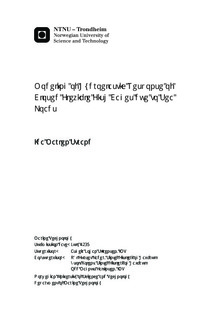Modeling of Hydroelastic Response of Closed Flexible Fish Cages due to Sea Loads
Master thesis
Date
2013Metadata
Show full item recordCollections
- Institutt for marin teknikk [3448]
Abstract
Norway is presently the worlds biggest producer of Atlantic salmon. The traditionally used open-net-structures are probably the most important reason for the Norwegian success.The very nature of aquaculture, where fish is grown at a much higher density than appear naturally, makes it likely to affect the existing surrounding environment. Views on weaknesses related to the traditional technology have been stated. These weaknesses concern sustainability challenges related to escapes, sea-lice, diseases and pollution. Closed Flexible Fish Cages are proposed used in the sea, to meet with ecological challenges in the aquaculture industry. In a closed fish production system, the farmer has increased control of how the fish are exposed to the environment, by controlling the flow and quality of the water entering and leaving the bag.A closed flexible floating system is not far from the currently used net cage fish farm systems, and may therefore be easier to put directly into operation. Even though a CFC seems to be an attractive solution, the existing knowledge about how the CFC will respond to external sea loads are limited. More knowledge is needed to understand the response of the cage if this technology are to be utilized in an industrial scale. Experimental data from towing experiments conducted in the summer of 2012, are analysed to better understand the current forces with connected deformations on the bag for different filling levels. The analysed bag showed an increased tendency to deform for decreasing filling levels, leading to an increase in drag coefficient.A new method for mathematical modelling of the increase in drag, by a filling-level-dependent drag coefficient is proposed. Earlier experiences with structural collapse of a similarconcept have shown that it is crucial to secure the cage against raptures and escapes. To assure this, a method to detect leakage and pump failure at an early stage must be developed. To detectleakages it is important to know how the bag deforms under static conditions for lower filling levels. Experimental data from experiments conducted in the spring of 2013 was analysed related to deformations on the bag for different filling levels, with and without applied passive control by braces, under static conditions. A new method for modelling the deformed shape of the bag for decreasing filling levels is proposed.
